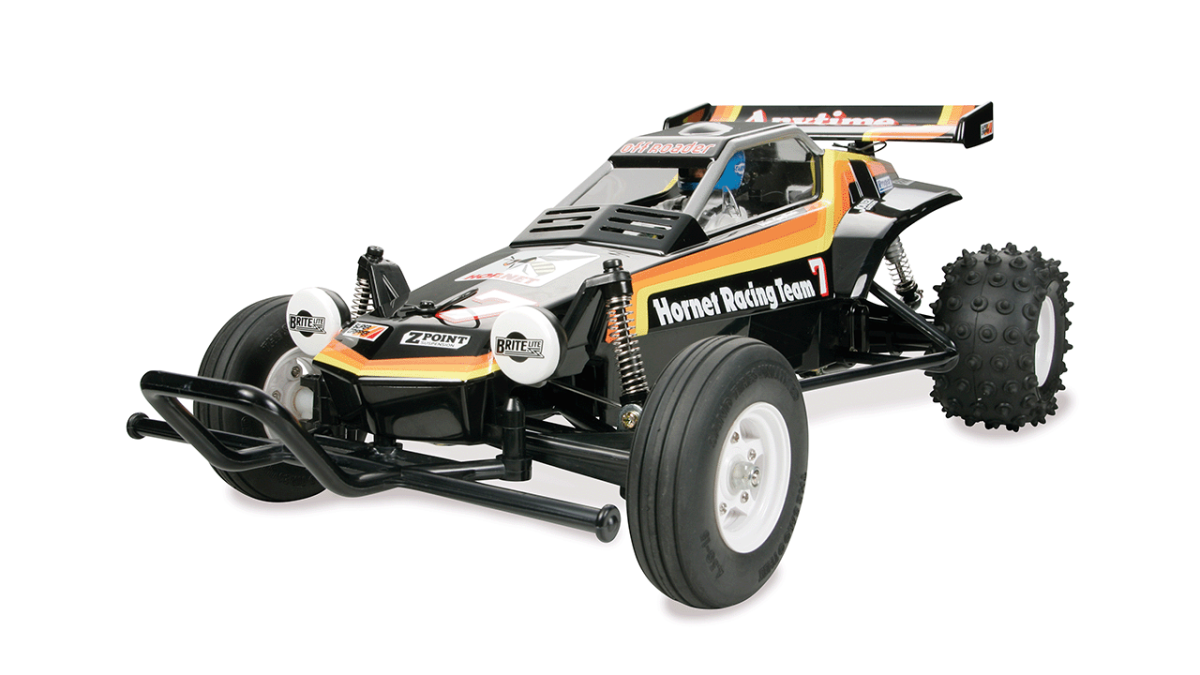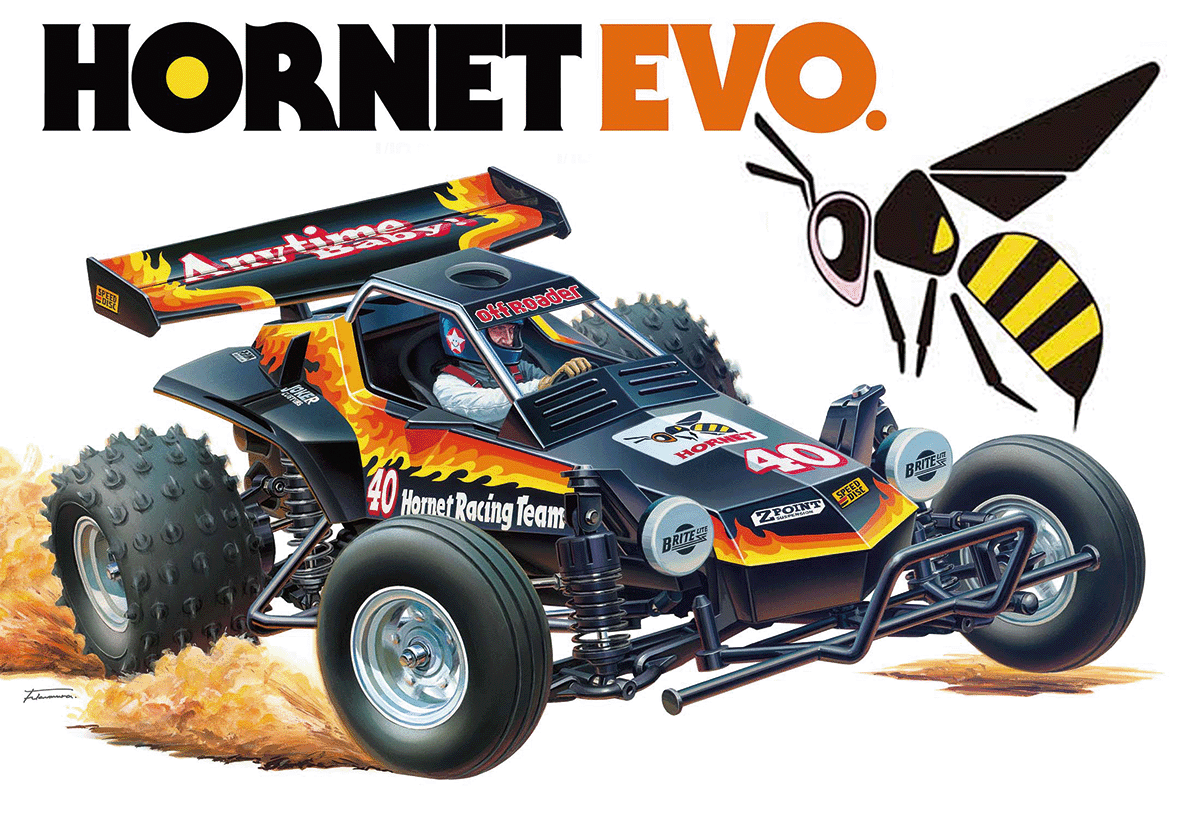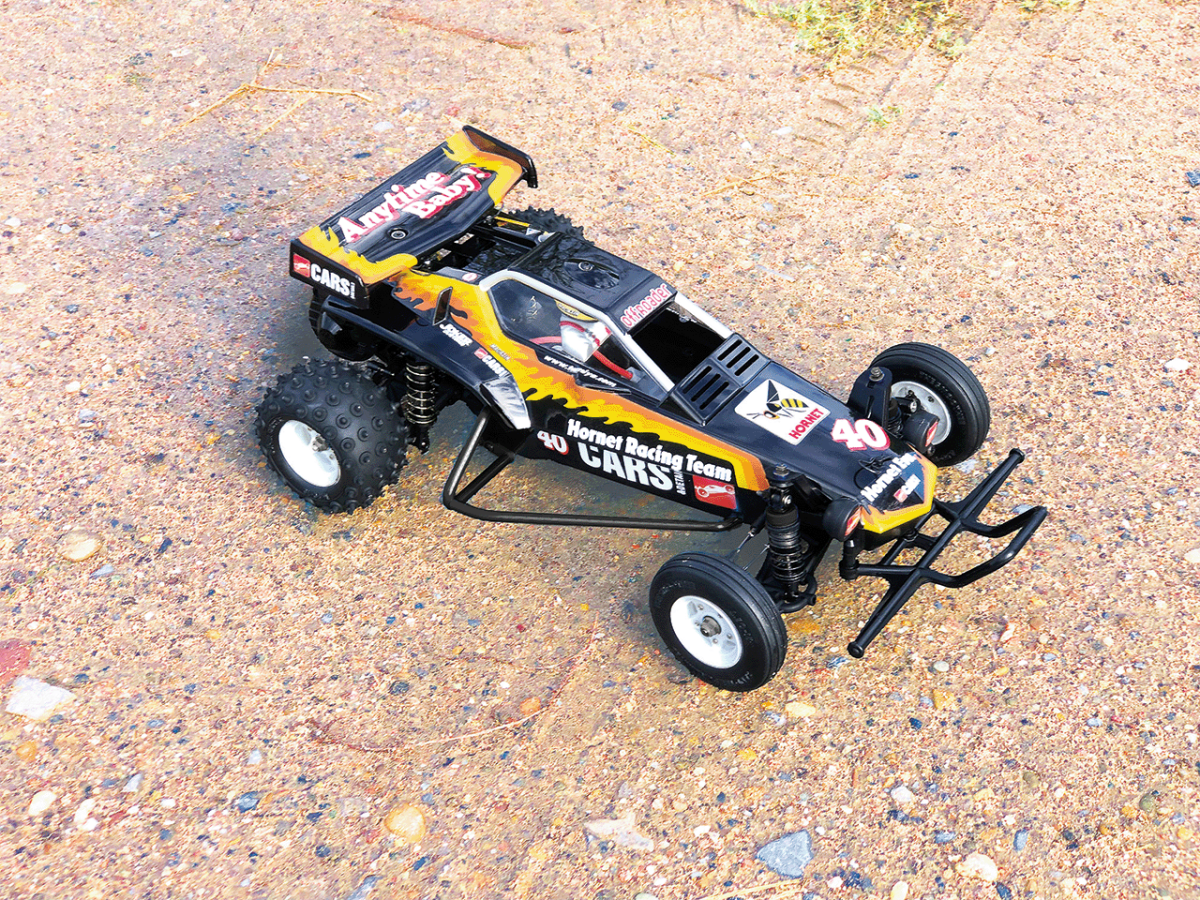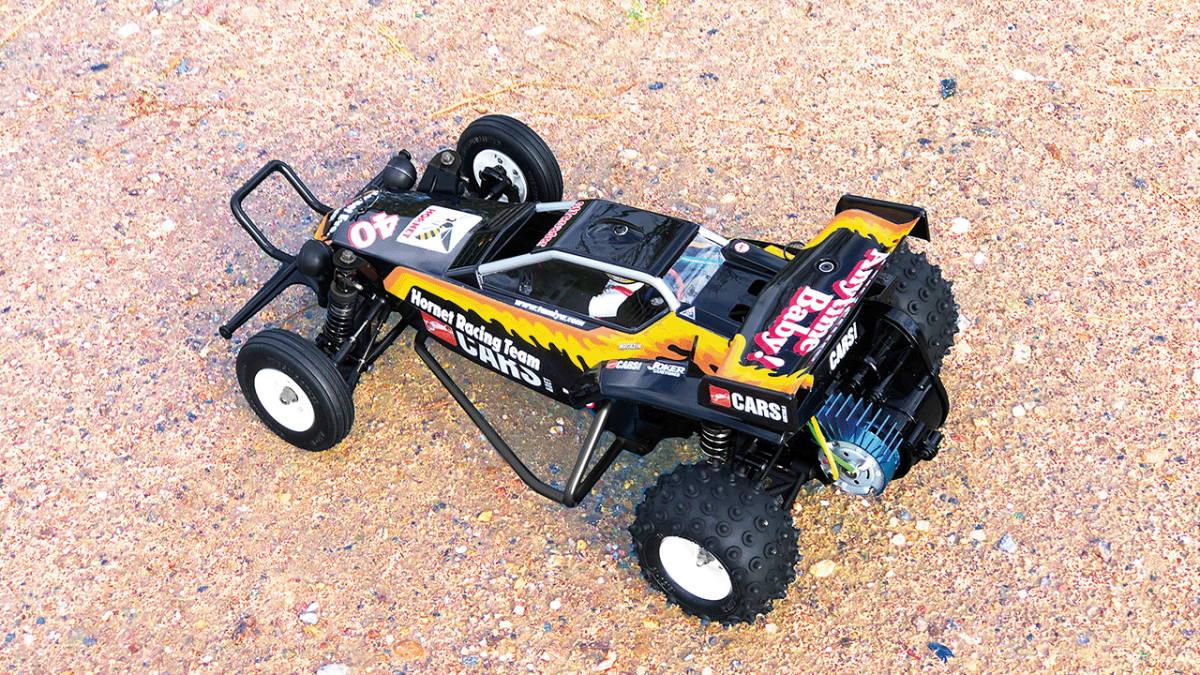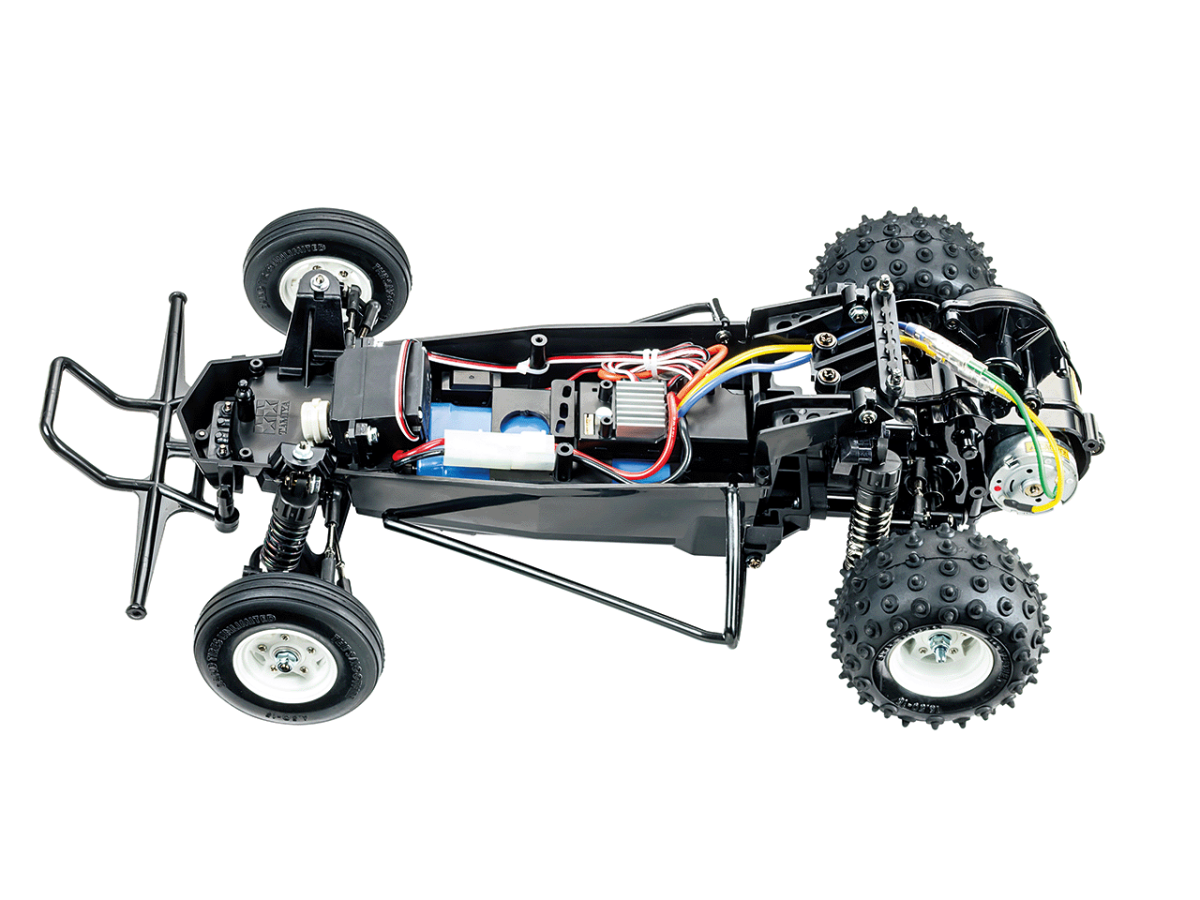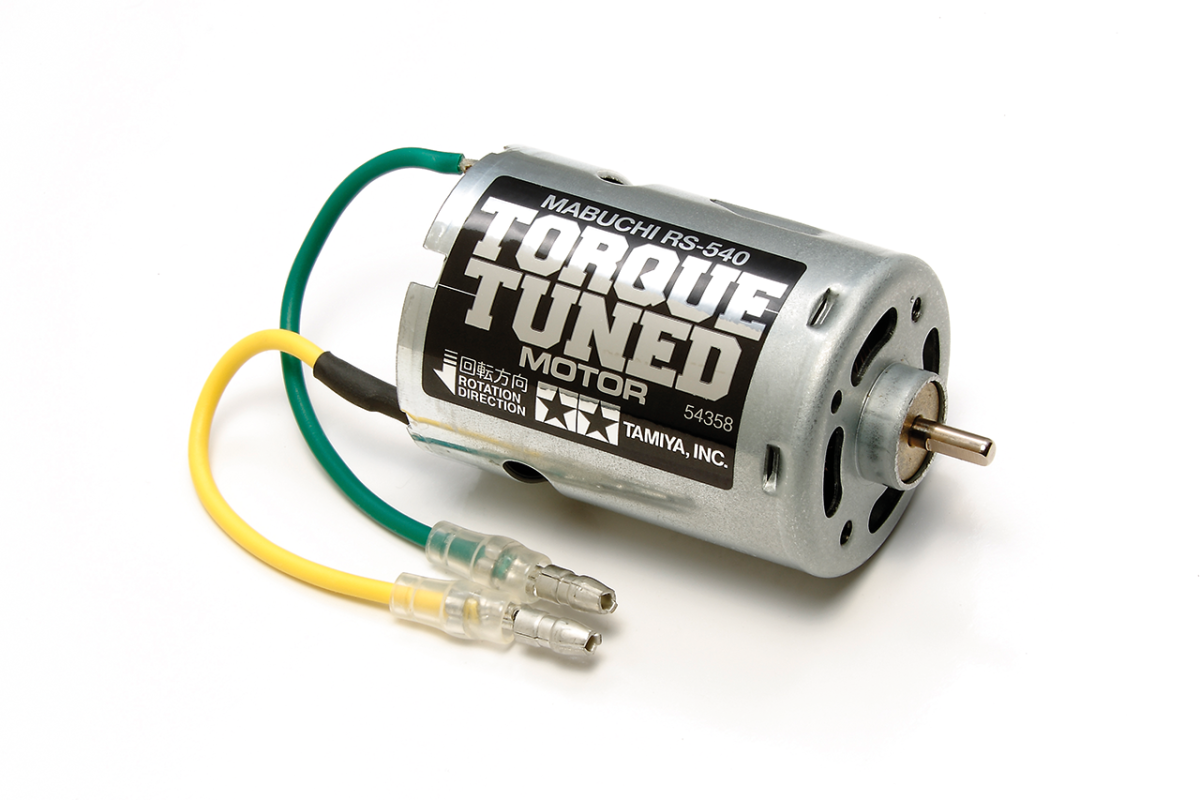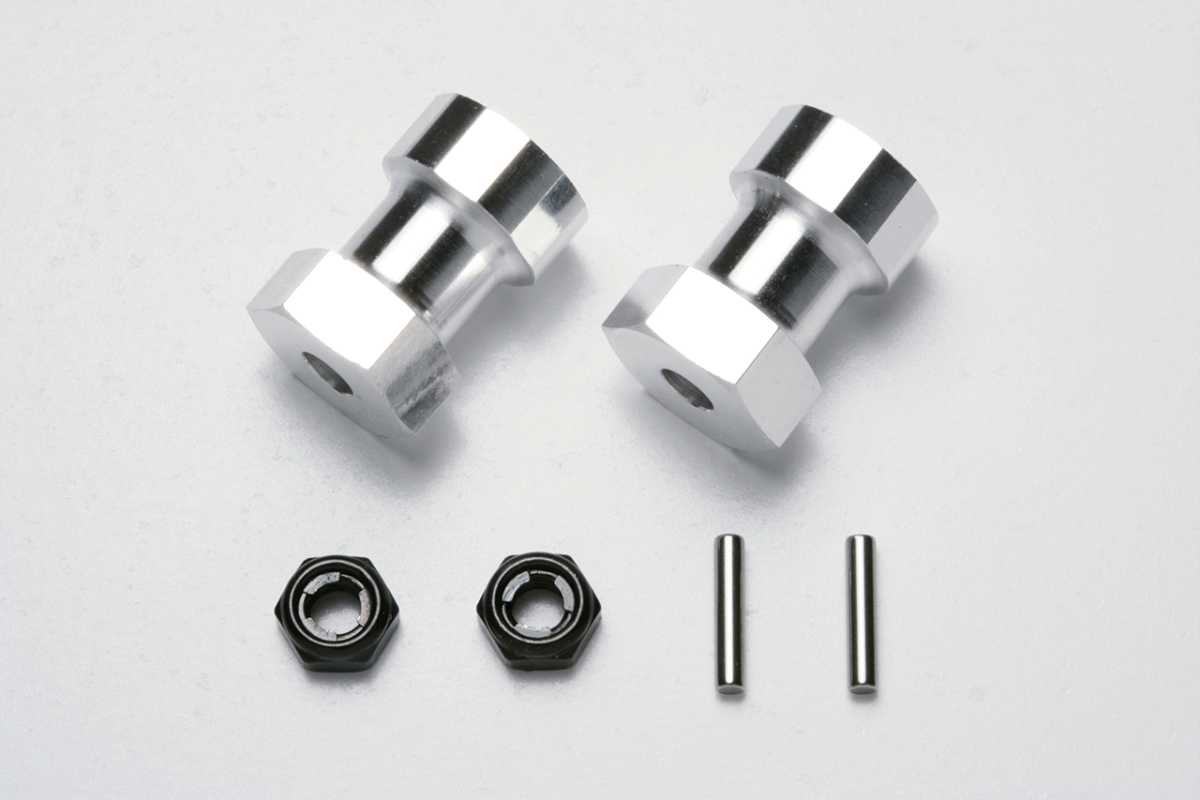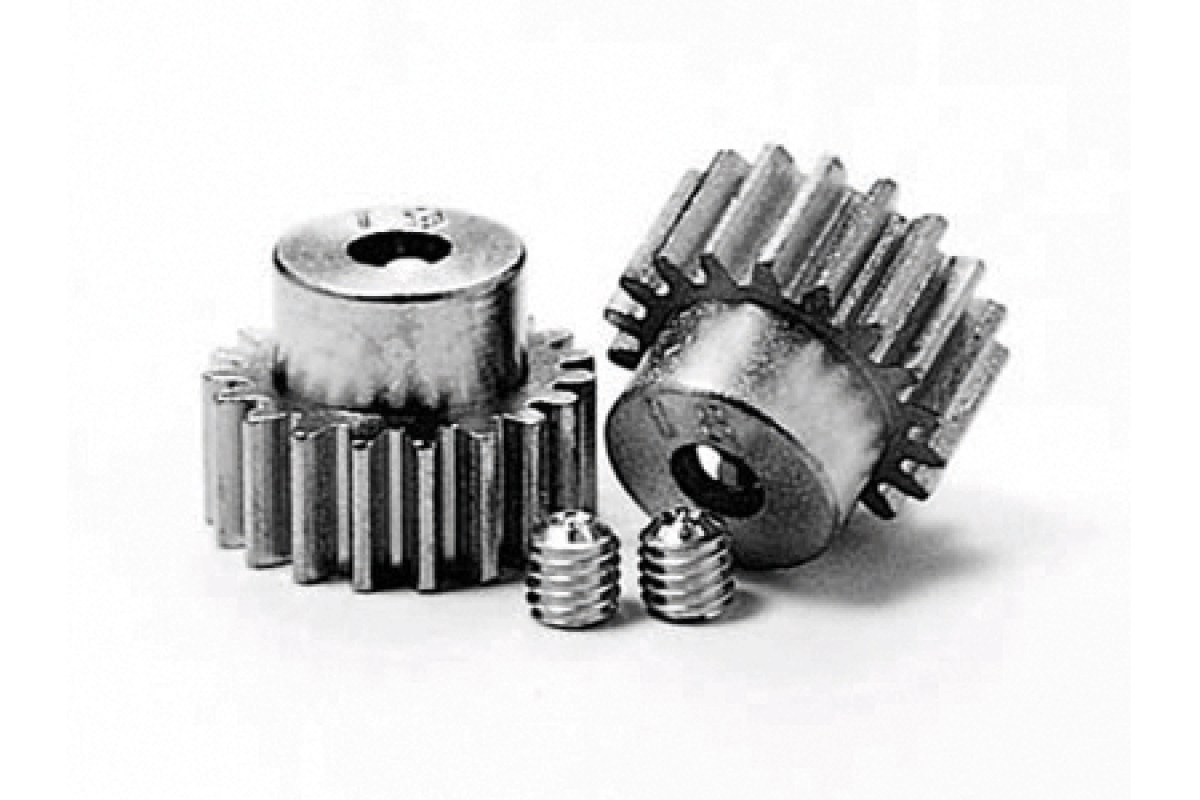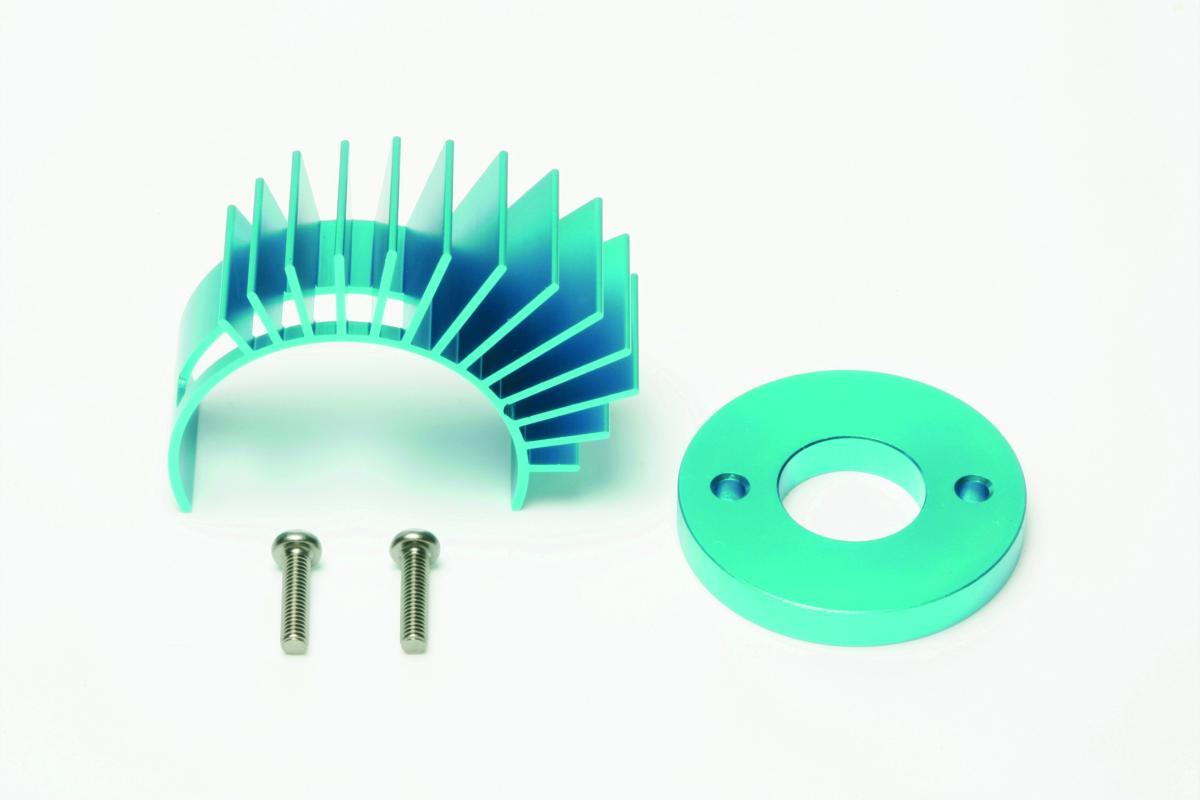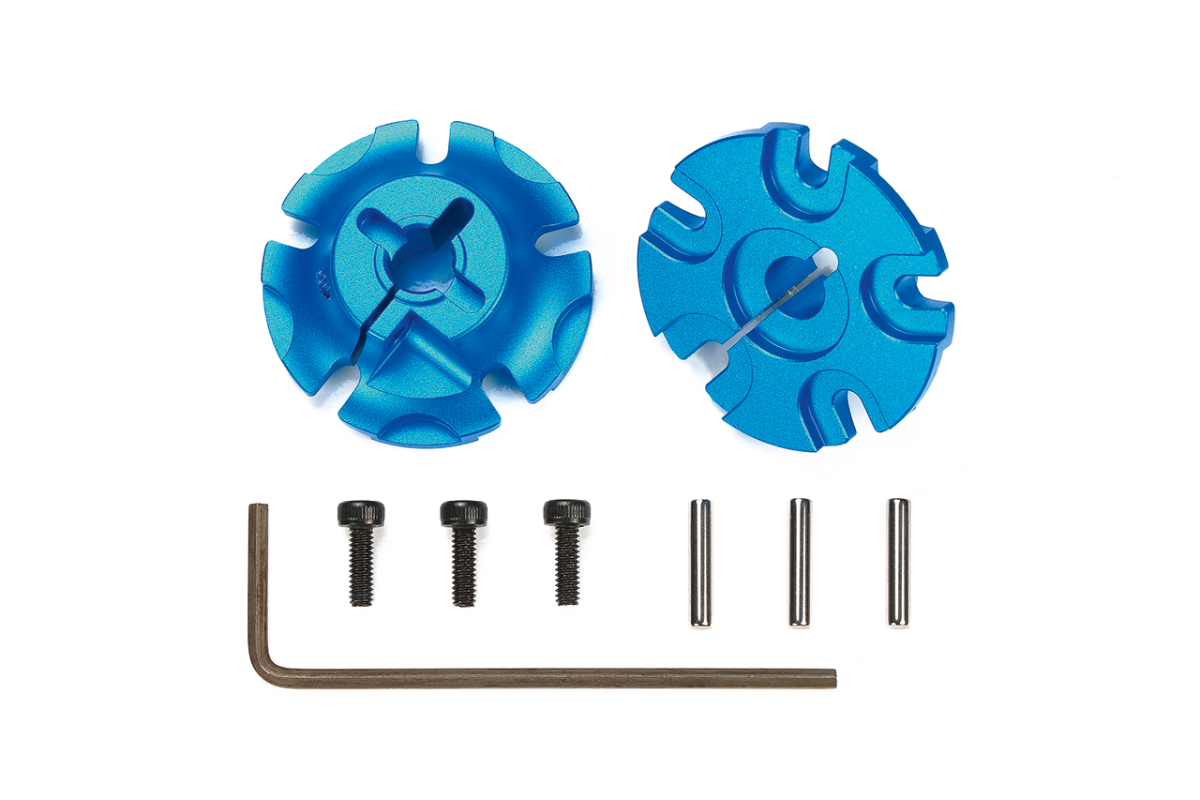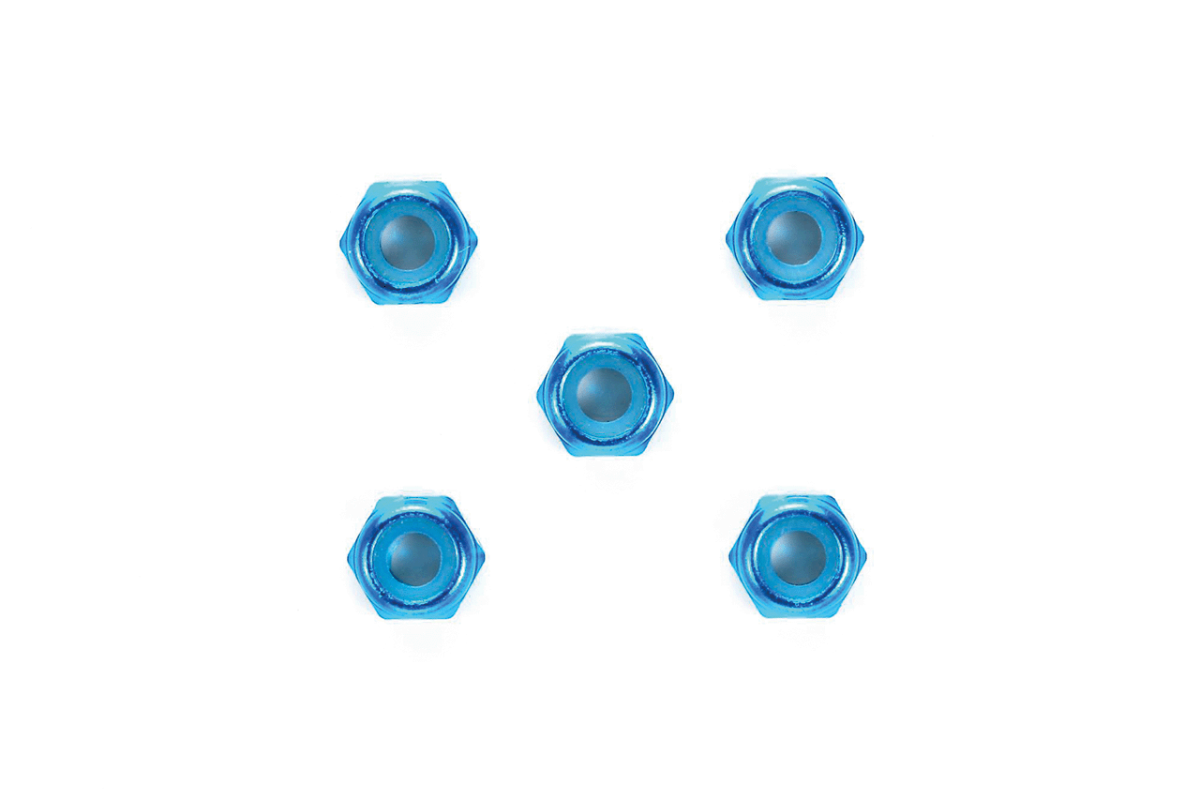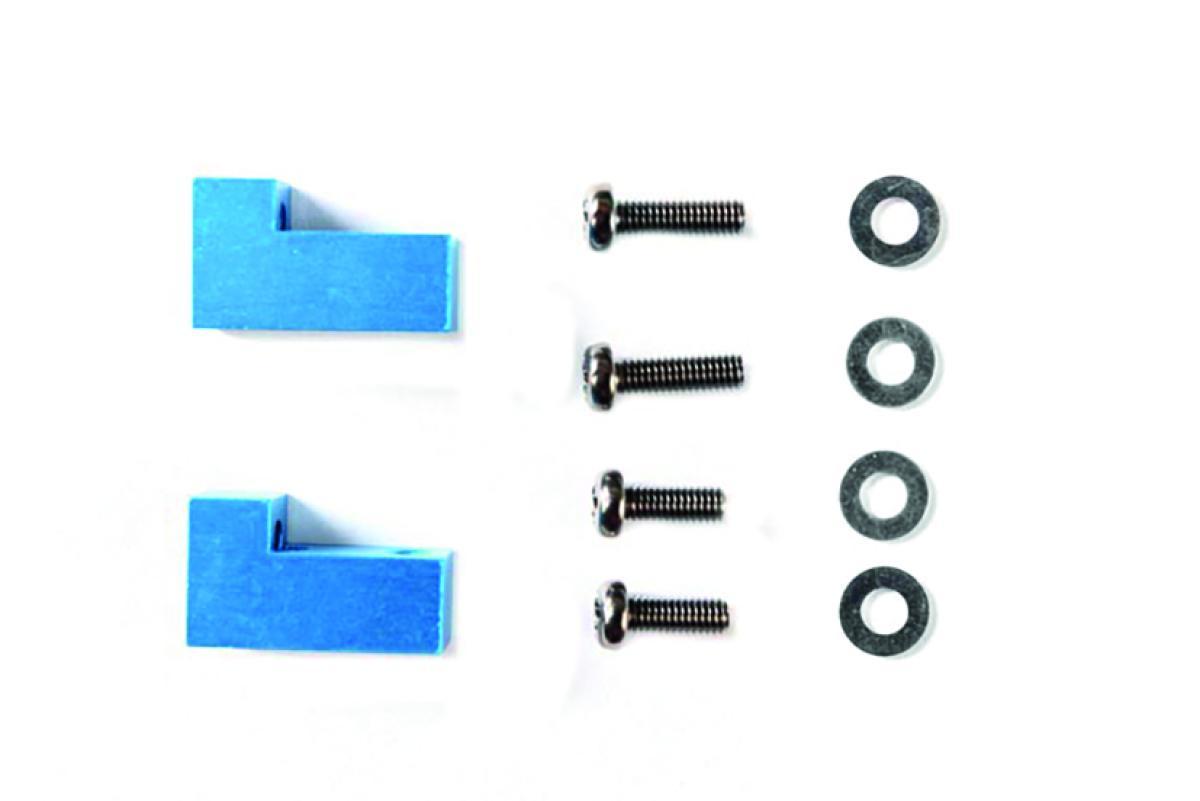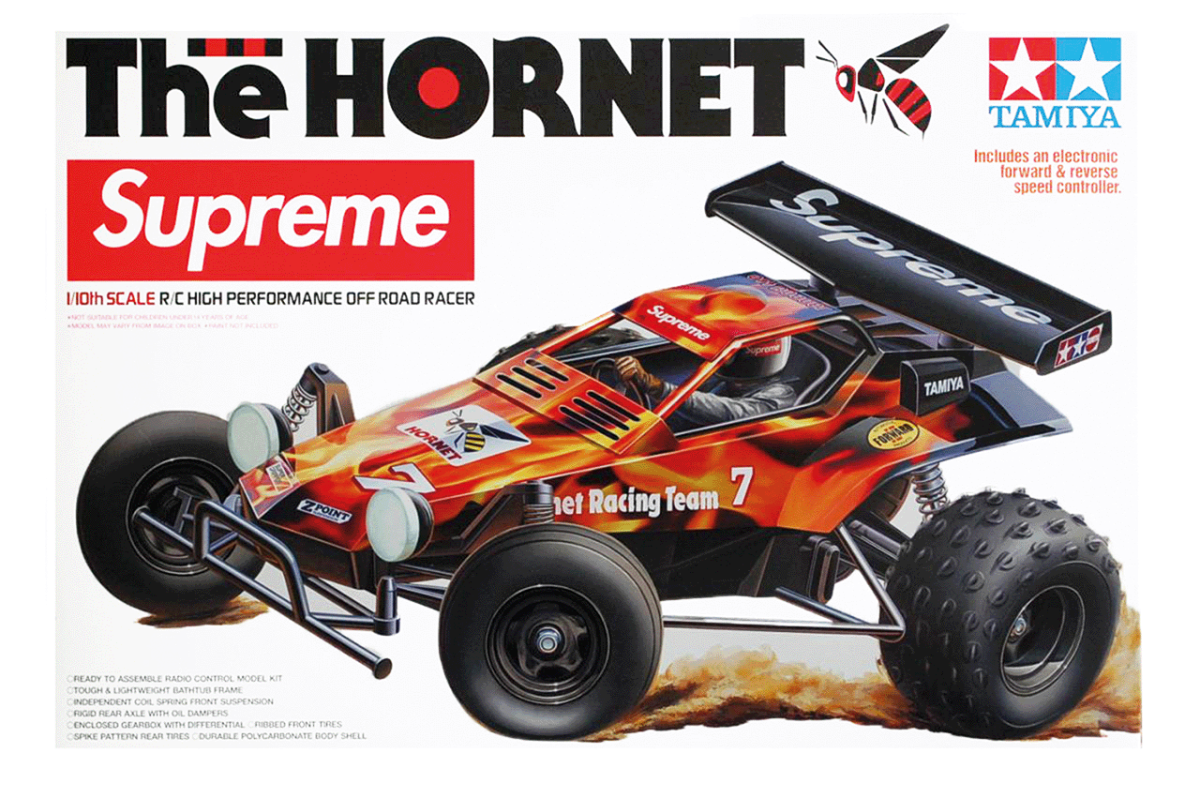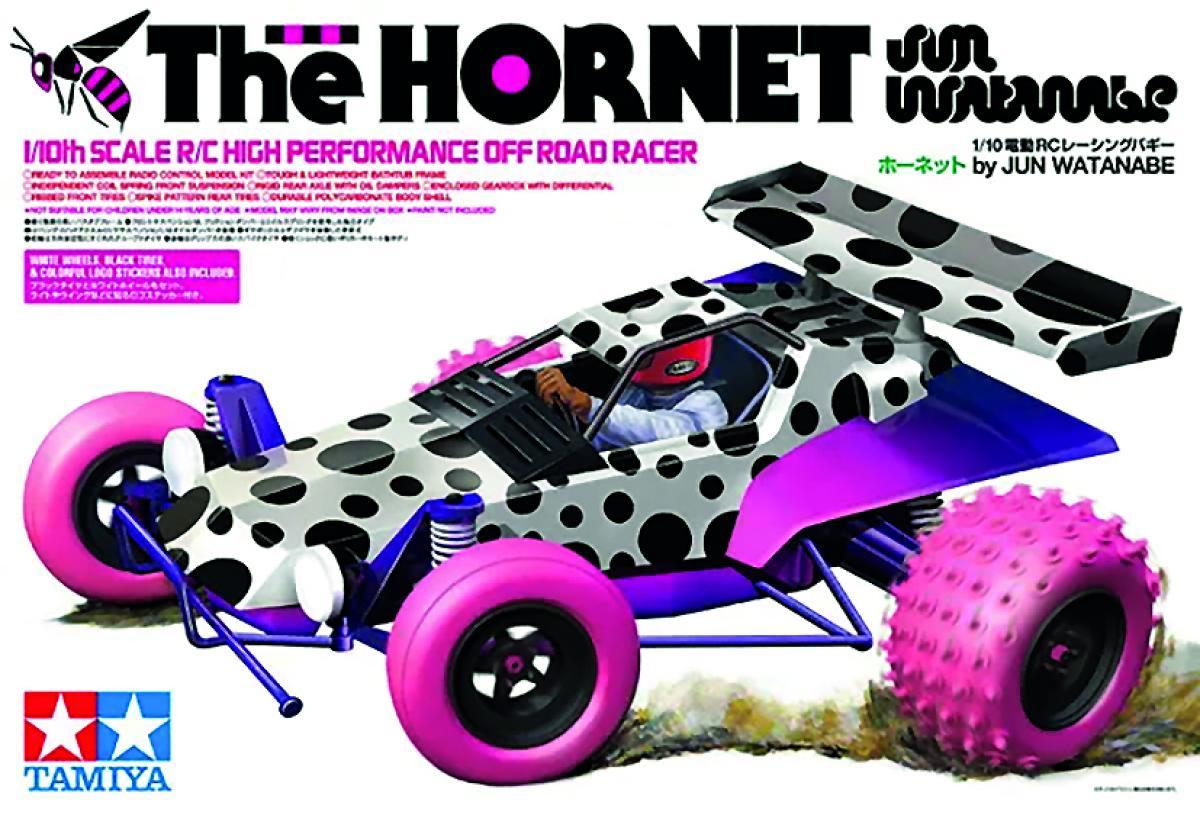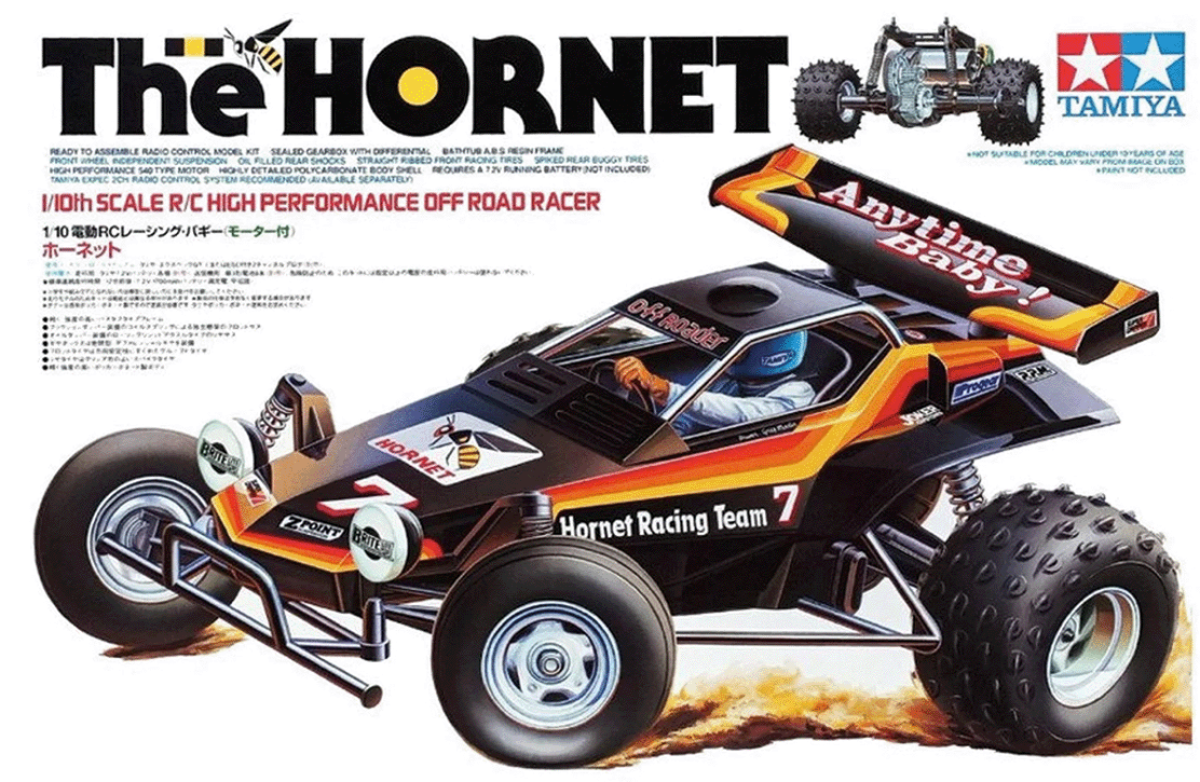Fascination Hornet
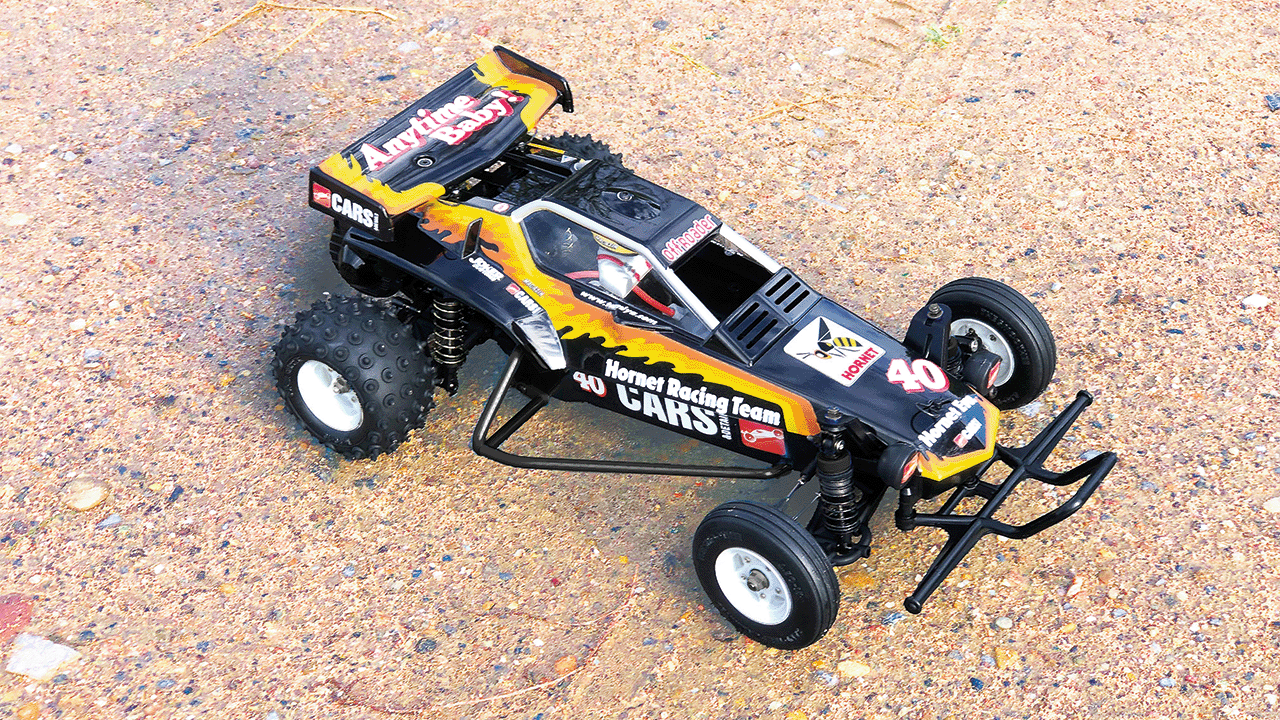
-
By
Cars&Details
Stab right into the heart! A test report
In 2024, the Hornet from Tamiya celebrates its 40th birthday. Reason enough for Tamiya to celebrate this extensively with a special model - the Hornet-EVO.
At first glance, you see the familiar entry-level model from 1984, but the kit has been completely redesigned.
Only the chassis tub is still from the original. Here we go! Let's take a closer look at the Hornet-EVO under its beautiful polycarbonate skin.
The original model of the Hornet was a so-called 2WD rigid-axle buggy. The rear axle was fitted with an oscillating rigid-axle unit and a simple front axle, which had extreme camber changes when deflected. In the Hornet EVO kit, everything was redesigned around the classic chassis tub. By Tamiya standards, the kit is very generously equipped. The kit includes four CVA oil pressure shock absorbers, seven track rods with right/left-hand threads and 20 ball bearings!
The complete transmission comes from the DT-02 chassis, with a robust bevel differential and large gears.Steel bones transmit the engine power to the wheels. The rear wheel carriers are also from the DT-02, but are guided by newly designed lower wishbones. The camber is infinitely adjustable here. Also new are three frame parts that connect the rear axle unit to the original chassis tub.
We would like to take this opportunity to note the new front axle unit with admiration and praise for the designers from Shizuoka. A new front wheel suspension with double wishbones was fitted in the rather limited space in the front part of the chassis tub. In addition, a sophisticated steering system with six ball bearings was integrated. The steering knuckles and C-hubs are again borrowed from the DT-02 chassis and are connected to the adjustable track rods on the chassis. Additional reinforcements have been added to the upper damper mounts. The CVA oil-pressure shock absorbers are also well known to Tamiya fans and certainly calm the handling of the Hornet-EVO.
The tires of the buggy correspond to those of the original Hornet. Grooved tires are mounted on three-piece beadlock rims on the front axle, while the rear wheels are fitted with studded tires with high grip. The classic rim drivers on the rear axle can be replaced with the enclosed plastic adapters to allow the use of modern rims with 12 millimeter hexagonal mountings.
The clear body has been slightly adapted to the new front axle at the front. The already cut-out windshield and the six cut-outs in the area in front of it are also very attractive. Tamiya has provided a slightly revised decal sheet for the EVO version. The original straight decorative strips have been given a slight flame design and a car number to mark the 40th anniversary of the Hornet's market launch.
Construction kit with 20 ball bearings!
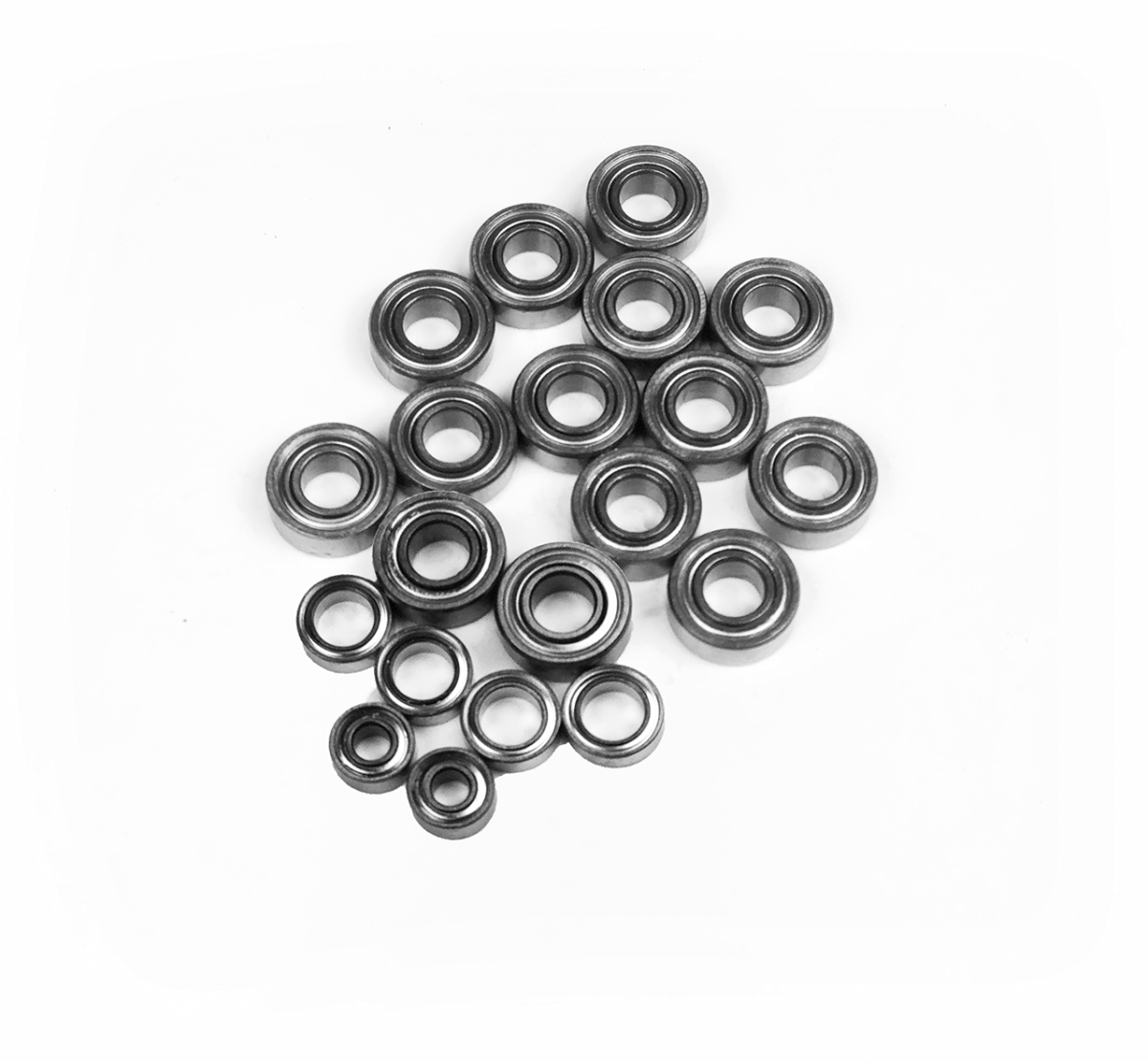
Less bumpsteering. The C-stroke was rotated by 180° and the ball head steering knuckle downwards
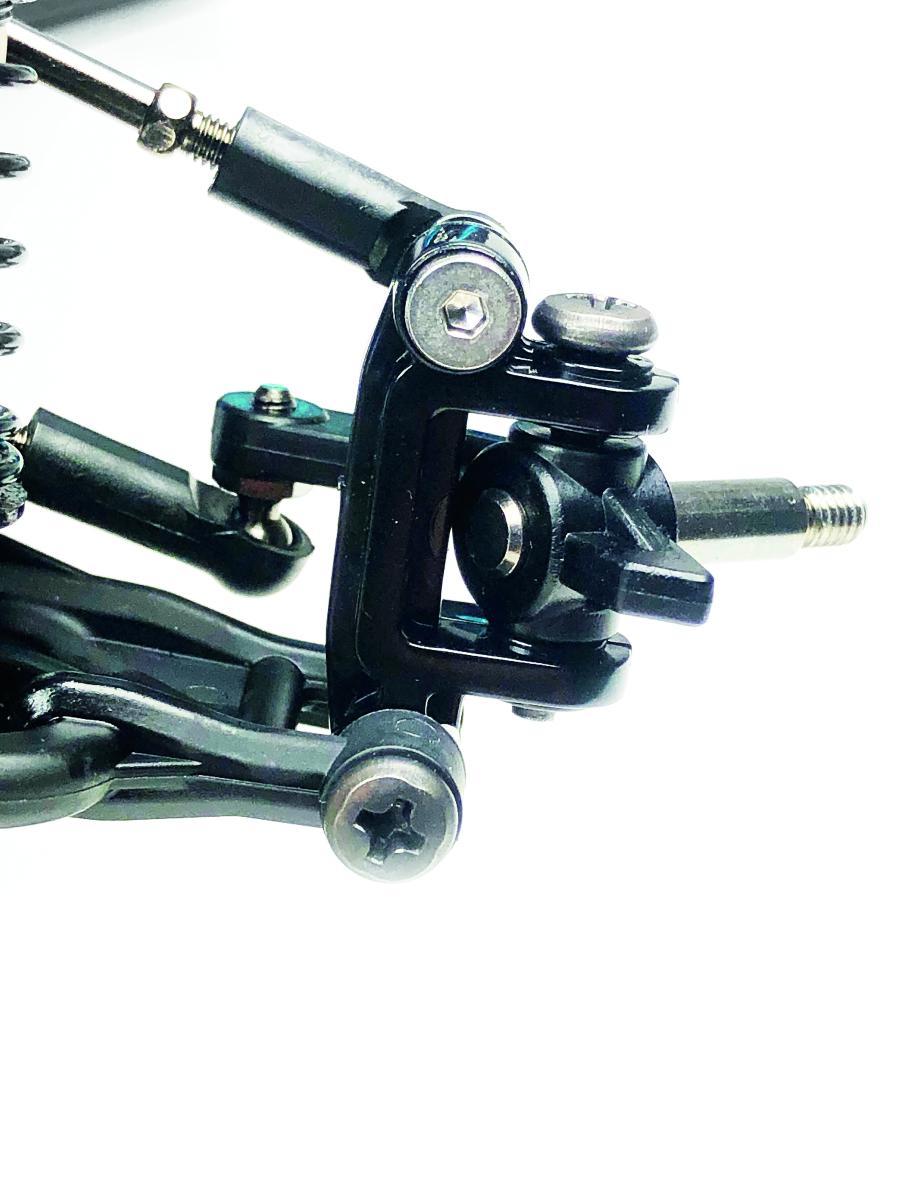
The DT-02 gearbox is connected to the original chassis tub with 3 new frame parts
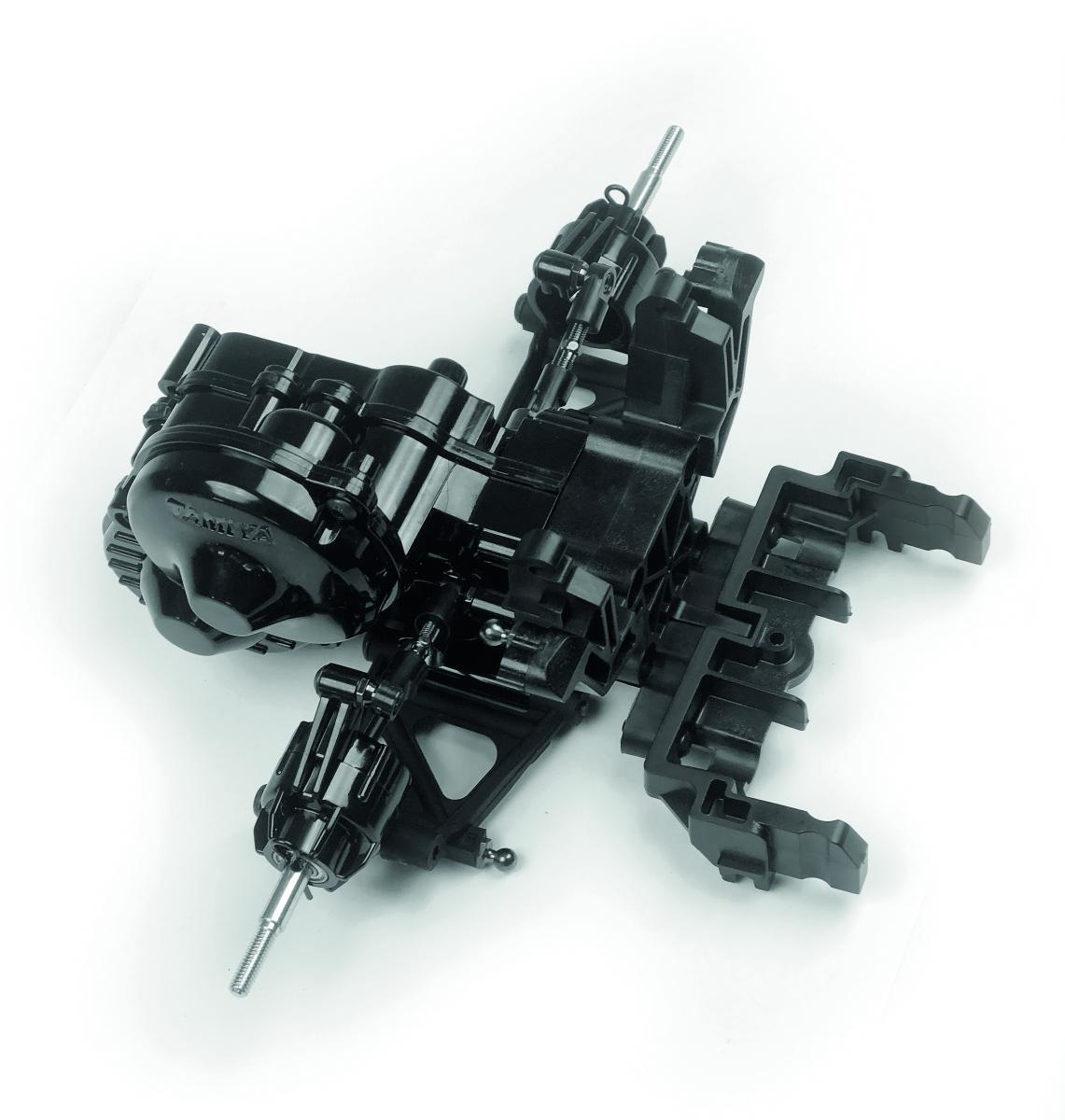
The new front axle of the Hornet-EVO viewed from below
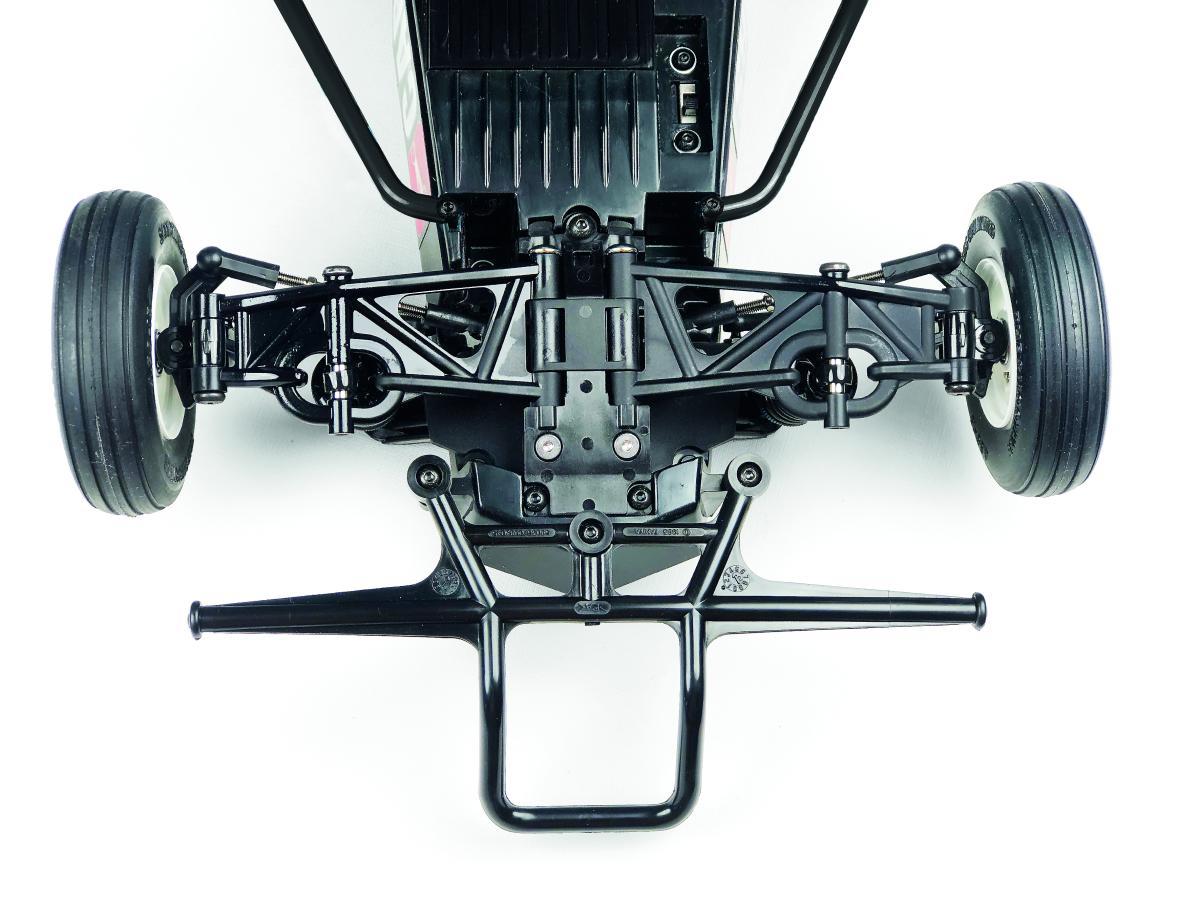
This Hornet EVO has been fitted with all kinds of optional tuning parts and so you can see a lot of blue
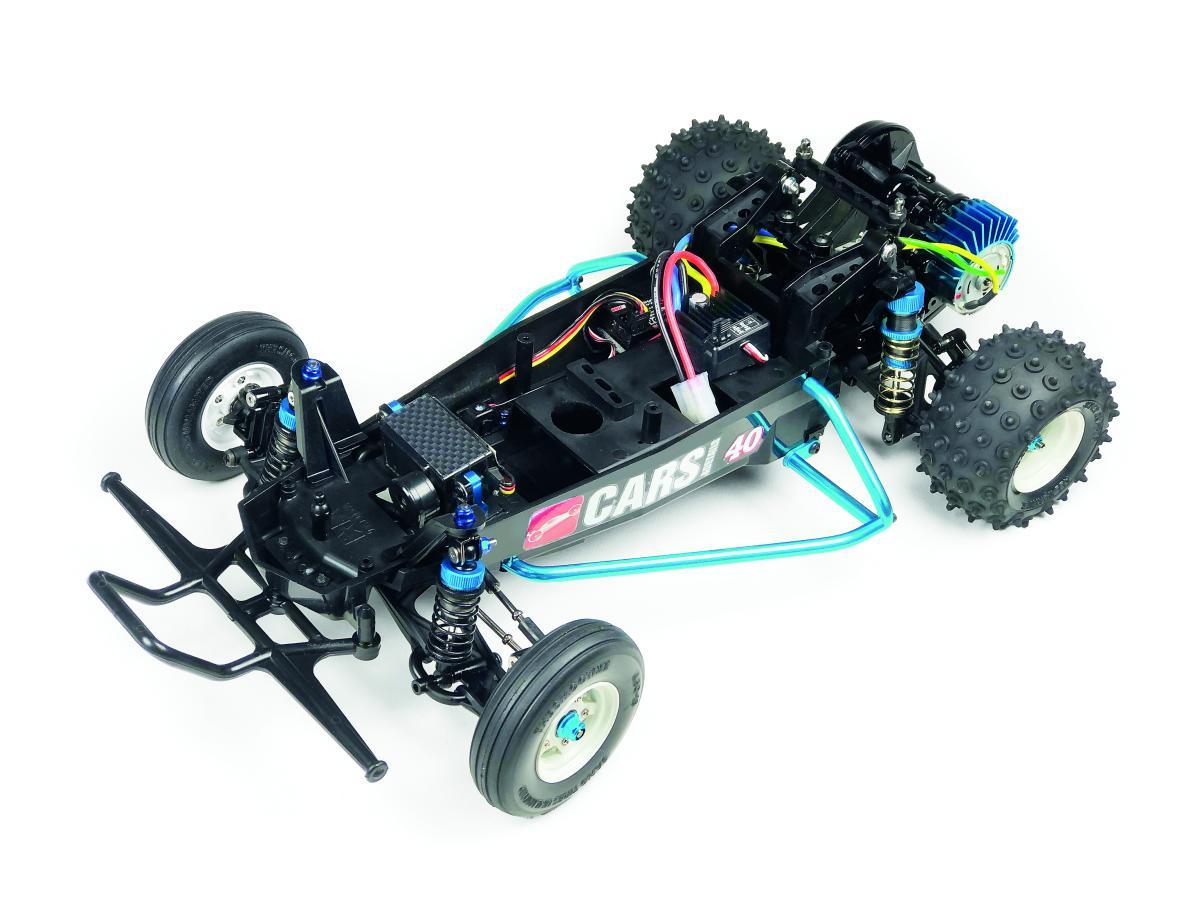
The Hornet Evo kit comes with a 540 electric motor and a Hobbywing speed controller. Other accessories required are a remote control with receiver, a steering servo, a drive battery, a charger and paint for polycarbonate bodies.
The assembly of a Tamiya Hornet model is actually always quite quick. This is also the case here. However, anyone who opts for a Hornet EVO model has certainly already had a long model building career and would like to build this special buggy to their own taste. This also applies to the author of this article. All the Phillips screws were replaced with M3 pan head screws with hexagon socket. After the first TRF conversions could already be seen on the Internet, our EVO model was given a few more blue parts from the accessories. The good CVA oil pressure shock absorbers were replaced with aluminum versions. The optional torque-tuned engine was given an aluminum cooling head. The rear wheels were also given aluminum mounts. At home, the EVO is fitted with the standard wheels, but modern wheelsets are used when driving.
Tuning:
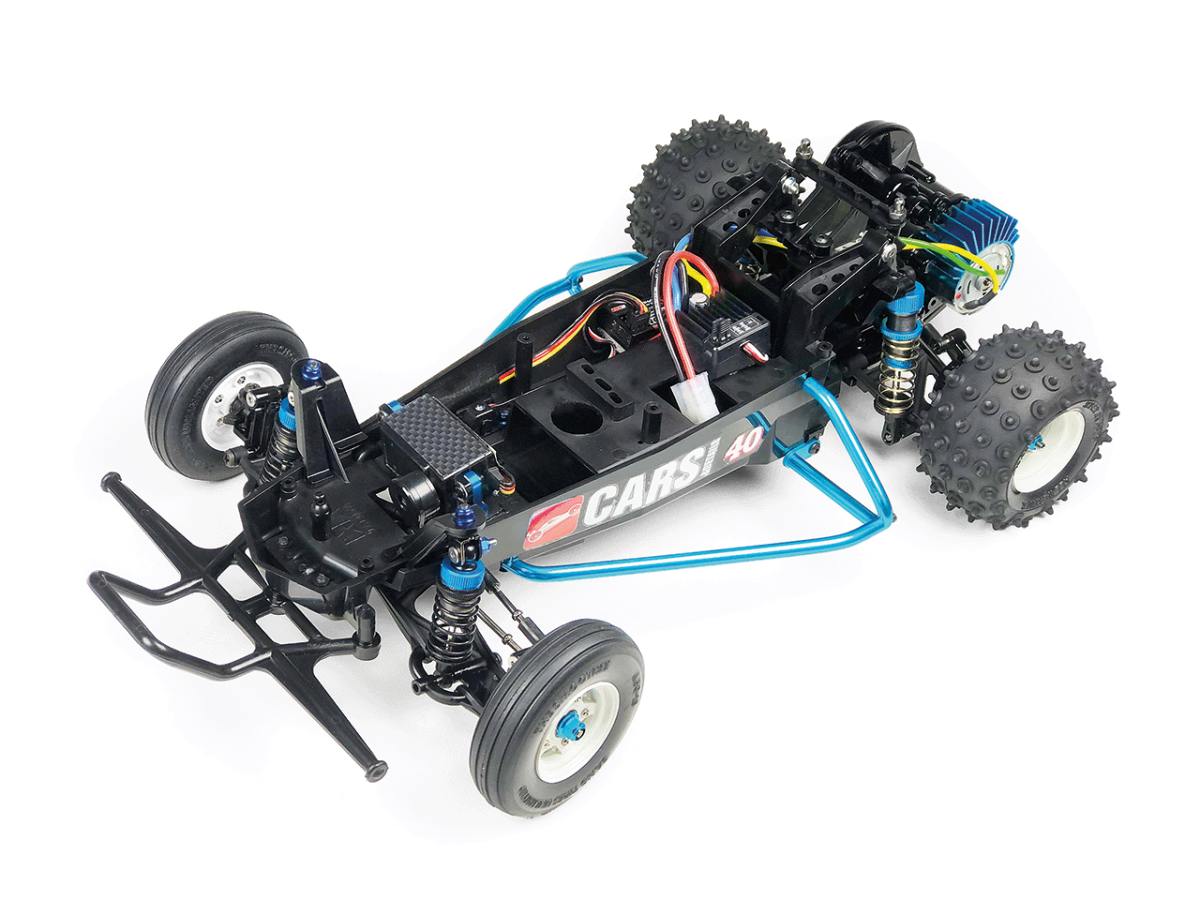
Hornet-EVO Hopup Parts
Standard Hornet EVO chassis
RS-540 Torque-Tuned #54358
HIGH TORQUE SERVO SAVER #51000
Wheel driver ALU #53913
Motor pinion set 18/19Z #50355
DT-02 aluminum engine heat sink #53831
Aluminum 5-point wheel driver #225043
Wheel nuts aluminum #53159
DT-02 Alu. Servo bracket #54397
The rear axle with optional shock absorbers and aluminum wheel hub
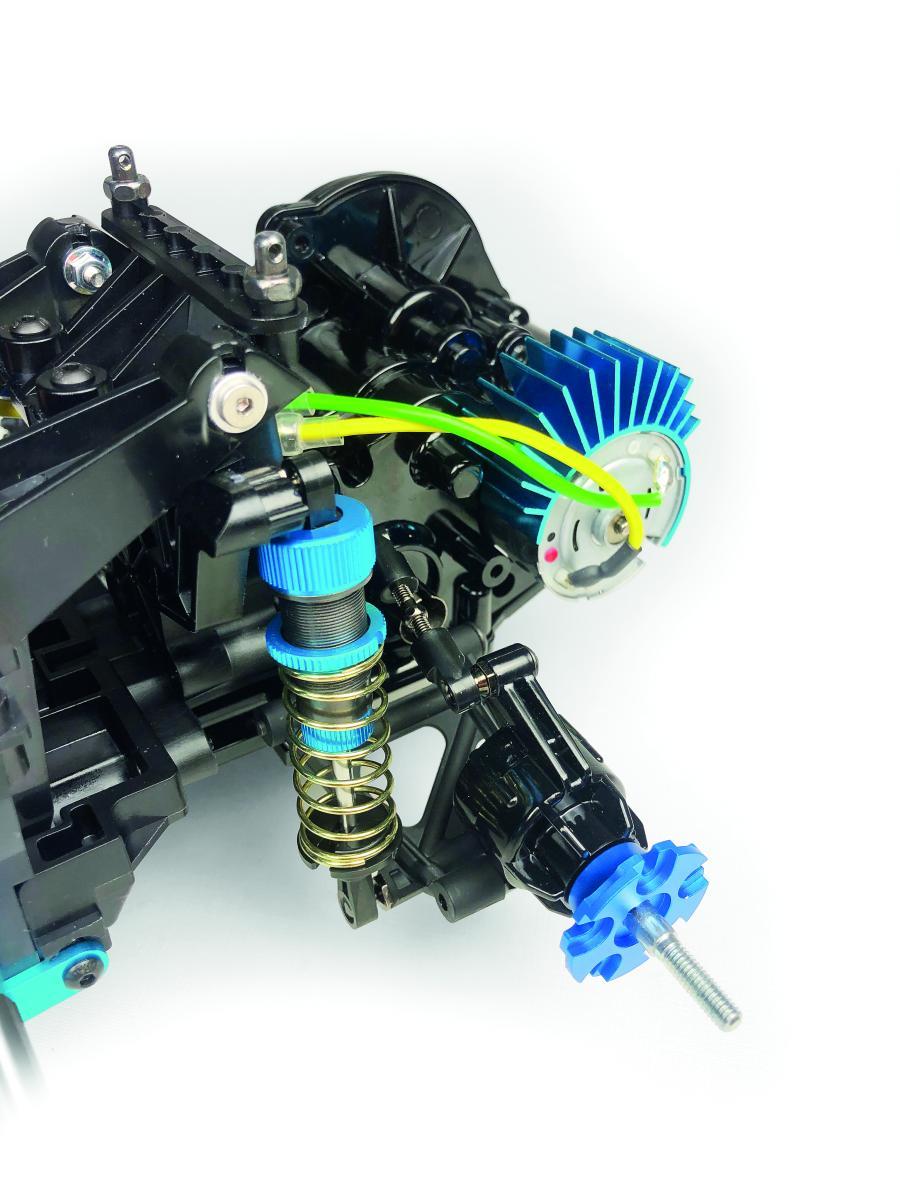
Driving test
So what should you compare the Hornet-EVO with? The classic Urhornet or a modern buggy? Of course, our souped-up Hornet Evo drives much more smoothly off-road than its predecessor. The use of four-wheel independent suspension noticeably improves the driving performance. However, we have changed the suspension points on the front axle to eliminate the annoying bumpsteering. The EVO now has a rear rotor configuration. This has shifted the weight distribution significantly to the rear, which gives the buggy more traction on the rear axle. However, the wheelbase of 251 millimetres is the same for both buggies. Different tires are used depending on the surface. And yes - we had endless fun with the Hornet-EVO. That's probably what matters most here.
Conclusion
Anyone who buys a Hornet EVO has certainly already developed an emotional attachment to the model. See the Hornet fascination. Building and tuning this little buggy is great fun. The author always enjoys looking at the finished car. And then new ideas come up about what else could be changed. With the Hornet-EVO, Tamiya has succeeded in making the famous sting in the model builder's heart. It's quite simple. Once a Hornet always a Hornet, or as it says on the rear wing: "Anytime Baby!"
Fascination Hornet
The Tamiya Hornet is probably one of the most iconic and best-selling RC buggies ever. It was first released on October 9, 1984 and sold for a period of eight years until 1992. In the sequence of the first 100th Tamiya RC models, the Hornet was the 45th model to be released.
But what is the fascination behind this successful concept? The first thing you used to see of a Tamiya model in the model store was the large, white packaging box with a highly dynamic graphic on the front. The Japanese company used this to draw attention to their models. Finally, the Hornet was the tuning version of the popular entry-level buggy Tamiya Grasshopper, which was also released in 1984. It also looked much more aggressive and was clearly faster thanks to its larger engine. The Grasshopper had a 380cc engine and the Hornet a 540cc engine. It had the better chassis thanks to the rear oil-pressure shock absorbers. It had the grippier tires and a lower center of gravity thanks to its lightweight polycarbonate body.
In those days, a Hornet was the boss in the ring among the many Grasshopper models. For many young people and kids, the Hornet was the GTi among entry-level buggies. A winning vehicle.This is also underlined by the name of this character car. Many buggies of the time were inspired by animal concepts. The hornet with its black and yellow body design signaled aggressiveness and the slogan on the rear wing "Anytime Baby" symbolized confidence and self-assurance. Of course, this was all the stuff children's dreams were made of.
The reissue of the Hornet was released by Tamiya in 2004 and has been a permanent part of the Japanese company's standard range ever since. This means that this RC model has been actively sold for over 28 years with one interruption. There have also been special models from Tamiya from time to time. In 2012 it was the Hornet by Jun Watanabe (58527) and in 2018 there was the special model of the Hornet Supreme (94211) of the New York brand "Supreme". The differences of the Supreme were the flaming decals and black wheels. The decor design of the EVO version was obviously inspired by the Supreme Hornet.
In 2024, the designers presented the Tamiya Hornet-EVO to mark its 40th anniversary. All the ideas and dreams that generations of model builders had imagined were realized around the original chassis. Every component has been reworked or redesigned. Only the bumper and the chassis tub have not been changed. However, the chassis tub still reads: 1984 Grasshopper. And so the circle closes again.
Text: Thomas Peter
Photos: Thomas Peter + Werk
Cars and Details Issue 06/2024
https://www.cars-and-details.de/produkt/car-details-einzelheft-06-2024/

